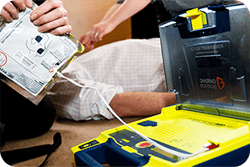Introduction to the Automated External Defibrillator

Automated External Defibrillator – Defibrillation is one crucial stage in a sequence of events that need to occur for the resuscitation of a victim of sudden cardiac arrest (SCA). This sequence, or ‘chain of survival’, starts by summoning the emergency services as soon as possible.
The second stage is providing basic cardiopulmonary resuscitation (chest compressions alternated with rescue breaths) to keep the victim alive until the third stage (defibrillation) can be performed. The automated external defibrillator (AED) has been described as the single most important development in the treatment of SCA.
These devices are now widely available and increasingly used by people, often with little or no training, to re-start the heart of a victim of SCA. Under ideal circumstances, when used very soon after collapse (within two or three minutes), many can survive.
How to use an Automated External Defibrillator
Basic Life Support and Safe Use of an Automated External Defibrillator – An AED (automated external defibrillator) in the workplace is an invaluable addition to health and safety provision for your employees as they are proven to save lives. With installation of any AED we highly recommend you train personnel in its usage.
Please see the video below on the application and use of an Automated External Defibrillator:
Automated External Defibrillators (AEDs) have been installed in many busy public places, workplaces, or other areas where the public have access. The intention is to use the machines to restart the heart as soon as possible. This strategy of placing AEDs in locations where they are used by lay persons near the arrest is known as public access defibrillation (PAD). Training to use an AED is an extension of the first aid skills possessed by first aid personnel and appointed persons. AEDs have been used successfully by untrained persons, and lack of training should not be a deterrent to their use.
For more information on how to use an Automated External Defibrillator please download the ‘guide to AEDs’ from the Resuscitation Council (UK) website for free.
For further information on training and courses available delivered directly in your workplace please see our Automated External Defibrillator training section.
